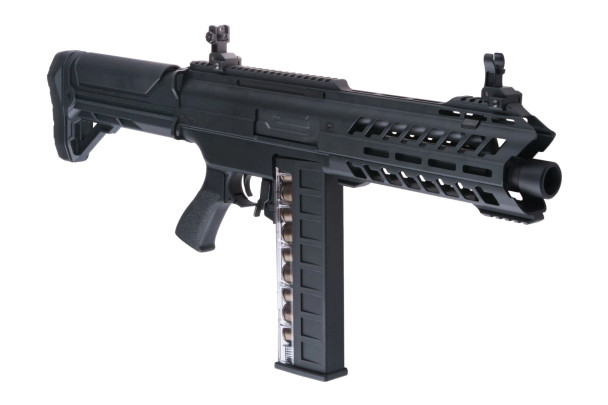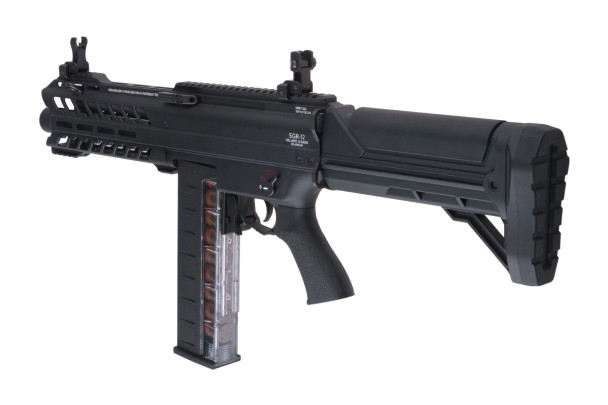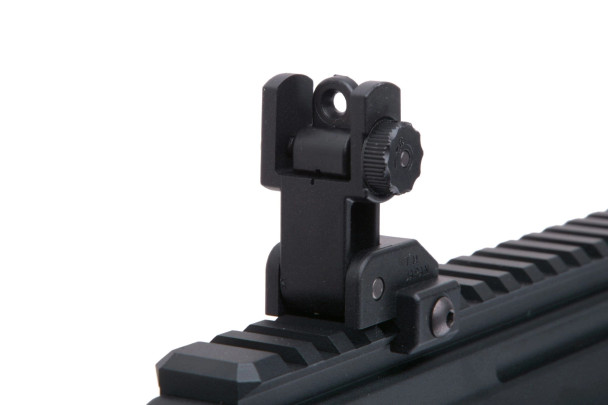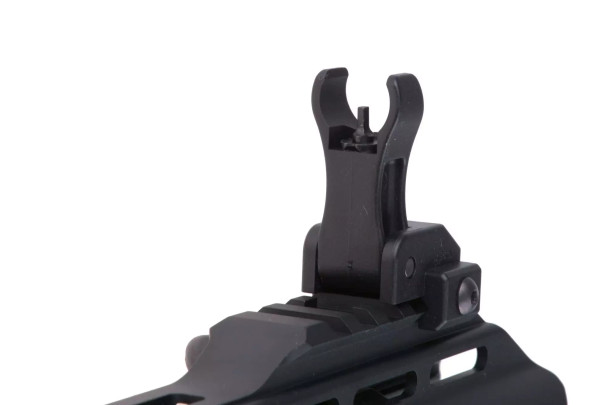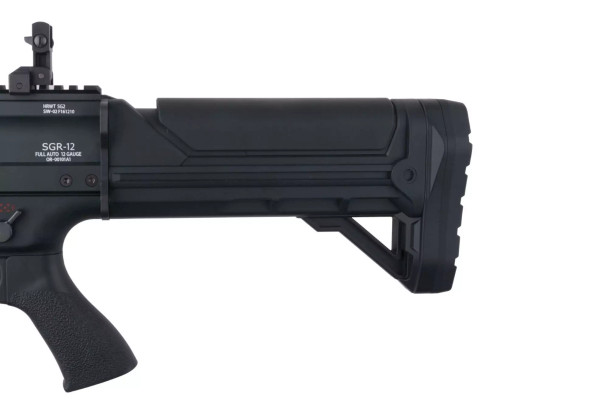Description
Tokyo Marui SGR-12 Electric Full Auto Shotgun
The Tokyo Marui SGR‑12 marks a huge leap in electric shotgun engineering. It’s not just another tri‑shot; it’s a fully automatic electric shotgun built with sophistication, modularity, and performance in mind. If you ever thought shotguns in airsoft were limited to slow pump actions or semi‑auto gimmicks, the SGR‑12 absolutely shatters that ceiling. In this writeup I’ll break down how it works, how it feels, where its strengths lie, and what to watch out for. Think of this like the field manual from a gear‑obsessed airsofter.
Design Philosophy & Context
Tokyo Marui has never been content to rest on past successes, and the SGR‑12 is proof. Their SledgeHammer tri‑shot design already set a solid precedent: three barrels, synchronized fire, etc. But the SGR‑12 ups the ante with full auto capability, better internals, and greater customization. It’s their second generation of electric tri‑shot, optimized for more consistent performance and greater user control.
Marui has aimed to merge the punch of a shotgun with the flexibility of an AEG: selective fire modes, modular rails, adjustable hop, and a sturdy frame. In many ways, this shotgun lives in the hybrid space between a tactical rifle and a power tool—designed to dominate close-quarters with style.
Mechanism & Internals
At its heart, the SGR‑12 uses a 3‑cylinder mechanical “box” system. Unlike traditional AEGs with one cylinder pushing one BB, each barrel has its own cylinder and hop-up assembly. Pull the trigger, and all three cylinders fire concurrently. The trick is getting those three shots to cycle smoothly and reliably, especially under sustained full-auto use.
To facilitate that, Marui uses a Kashima-coated self-lubricating nozzle guide. That’s a fancy way of saying they’ve coated the internal guides in a slick alumite finish that reduces friction and helps BBs seat cleanly—even when firing all three barrels in rapid succession. This makes feeding more reliable, less prone to jams or mis-feeds.
They also include FET (electronic switch) technology. Mechanical switches handling triple firing (especially in full auto) take a beating: arcing, carbon buildup, wear. The FET reduces load on the contacts, giving faster trigger response and less mechanical stress. Combined with the shot synchronization, you get a path from trigger to BB that feels snappy and consistent.
The external frame encloses a metal inner frame, meaning the guts are supported by solid structure, not just plastic. That rigidity matters when you’re pulsing recoil or dropping the shotgun in play. And since three barrels need alignment, everything must remain stable under stress.
Each of the three barrels is paired with its own variable hop-up, adjustable via dials in the ejection port. That’s major: you can tune each barrel to optimize range, spread, or balance. It opens up possibilities like having two barrels for spread and one for tighter range, or tweaking them to converge at different distances.
Firing Modes & Behavior
One of the SGR‑12’s standout features is that it supports both semi-automatic (i.e. one triple-shot per trigger pull) and full-automatic modes. In full auto, it’s capable of pushing out ~10 cycles per second—i.e. 30 BBs per second (3 × 10) if the trigger stays held. That’s a sustained barrage for a shotgun. In semi mode, each pull fires three BBs simultaneously, giving more controlled bursts.
Mechanically, that’s impressive. The selector switch on the side toggles modes. The FET helps ensure the electronics keep up without overloading. And because each barrel cycles individually, the timing must be precise to keep all three in sync without one lagging or misfiring.
One more smart feature: auto-stop on empty magazine. When your magazine (box type, 93 rounds standard) is depleted, the SGR‑12 halts firing. You reload, hit the bolt catch or trigger, and you’re back in business. This prevents dry-firing cycles that can stress internals.
External Features & Customization
Marui didn’t skimp on the exterior. The shotgun uses a modern M-LOK rail system built into an aluminum-cut handguard. This slim, modular design allows you to mount rails only where you need them—reducing weight and bulk. They supply M-LOK panels in 3-slot, 5-slot, and 7-slot widths, attachable/detachable with the included hex wrench. That’s ideal if you want to mount lights, grips, lasers, or other accessories without overloading.
The upper receiver is integrated with the handguard, giving continuity in the sight rail and strength in the structure. Flip-up front and rear sights are included; both are adjustable for elevation (and the rear for windage). They’ll serve as fallback iron sights if you're not running optics.
The magazine is a box-type, semi-transparent 96-round unit. You can see dummy shells inside, giving that fun visual feedback (are you almost out? better reload). The transparency adds showmanship, and the capacity is generous for a shotgun.
Externally, the frame is a mix of materials: an alloy upper, M-LOK handguard, and polymer lower components (stock, lower receiver, grip). That balance keeps weight manageable while ensuring durability where it’s needed.
One piece of clever design: the shotgun rejects battery packs that are too powerful. If you try to insert an 11.1V LiPo or something beyond spec, it’ll prevent firing and trigger a red LED. That protects the internals from overvoltage damage—a smart safety layer for users.
Specifications & Handling
Here are the key specs and how they translate to feel and use:
-
Full length: ~730 mm
-
Barrel length: 270 mm
-
Weight: ~4,400 g (with empty magazine)
-
Ammo: 6mm BB (0.20g – 0.25g recommended)
-
Magazine capacity: 96 rounds
-
Power source: Mini S-type battery (battery not included)
-
Fire modes: Semi / Full auto
-
Tri-barrel system with independent variable hop-ups
In practice, the SGR‑12 carries weight. At 4.4 kg, it’s heavier than many rifles, but you feel that solidity in play—it’s no toy. The balance is toward the receiver/mag area, so your arms take some load. But that weight helps absorb recoil impulses and steady the platform.
The M-LOK handguard is ergonomic enough to grip, not overly fat. It offers good clearance for your support hand, and rail segments can be placed where you need them. The magazine release is robust, and reloading the box mag is straightforward. The semi-transparent body also helps you gauge your remaining ammo.
Sighting is intuitive with flip-up irons, and if you mount an optic, the upper rail gives a straight shot line. The adjustable hop-up allows you to tailor each barrel’s trajectory—tweak for consistency, spread, or range as needed. For CQB games you might back off the hops a bit; for tighter maps or outdoor arenas, boost them.
The FET system’s responsiveness is noticeable. When you pull the trigger, there is little lag before the barrels fire, which gives the shotgun a “snappy” feel. Full-auto bursts are aggressive—and fun. But because each cycle shoots three BBs, you burn ammo fast. Strategy matters.
You’ll want to monitor battery voltage. The SGR‑12 expects a Mini S battery within spec. Overvoltage is blocked by design, as mentioned. Use quality cells, maintain charge, and avoid pushing beyond the safe envelope.
Strengths & Tactical Use Cases
-
Suppressive/Area Control
Because it can spray 30 BBs/second, the SGR‑12 excels at suppressing enemy movement. A well-placed burst can disorient and force opponents to seek cover. -
Close-Quarters Domination
In tight indoor maps or building interiors, the tri-shot burst gives you that “shotgun wall of lead” advantage without manual reloading. It gives you a heavy punch with minimal delay. -
Tactical Flexibility
With three hop-ups, you can fine-tune each barrel. Want one tighter, two looser? Or balance them for a pattern converge zone? That flexibility is unique to this style of shotgun. -
Accessory-rich Customization
The M-LOK rail system lets you outfit the shotgun exactly how you want. Tactical lights, grips, lasers—all mountable. You’re not locked into a bulky shell. -
Reliability & Protection
The metal inner frame and FET protection reduce failure points. The system’s built-in safeguards (auto-stop, overvoltage block) preserve longevity.
Challenges & Considerations
-
Weight & Fatigue
Four-plus kilos is no joke. Carrying it all day will fatigue shoulders. You’ll want a solid sling or support. -
Ammo Consumption
Each trigger pull produces three BBs. In full auto, you burn a lot of ammo fast. Smart fire discipline is a must. -
Battery Constraints
The system is strict about battery specs. You cannot push it with an overpowered pack. Use recommended Mini S batteries to avoid being locked out by the FET. -
Complexity
The internals are more intricate than classic AEGs or shotguns. If things go wrong, servicing might be more challenging—stick to stock or lightly tuned setups unless you really know what you're doing. -
Site Rules
Some skirmish sites disallow full auto shotguns or have limits on how many BBs per shot. Always check rulesets, since one trigger pull = 3 BBs.
Final Thoughts
The Tokyo Marui SGR‑12 is a milestone in airsoft shotgun tech. It bridges the gap between raw firepower and refined control. You get the full-auto aerial spray of a tri-barrel, the tuning finesse of triple hop-up, and the safety and responsiveness of modern electronics (thanks to FET). For players who want shock value, suppression ability, and functional precision all in one platform, this shotgun is a serious contender.
When you shoulder it in the field, the weight reminds you it’s built for battle. The snappy response makes you feel in command. And when that triple burst leaps out, you know you're wielding something more than a gimmick: you’re holding cutting-edge shotgun firepower made by a seasoned airsoft innovator.
If you decide to pick one up, treat it with respect, maintain it carefully, and stick to good batteries. Use its strengths when appropriate, control your ammo, and don’t try to push it past its design limits. Do that, and the SGR‑12 will absolutely dominate in close engagements and become a favorite you’ll brag about long after the skirmish ends.
Product Reviews
Delivery & Returns
Delivery Information
Affordable Shipping – Starting from Just £2.50
Our delivery prices begin at only £2.50 for UK mainland orders, with free standard delivery available on all orders over £100*. To quickly find out the exact shipping cost for your items, simply add everything to your basket. In the basket, you'll see a link under the subtotal titled "Estimate Shipping & Tax"—click this, enter your delivery details, and you’ll get a full quote including whether you qualify for free shipping.
Free Shipping Offers
- UK Mainland: Free on orders over £100*
- Northern Ireland, Republic of Ireland, Scottish Highlands & Islands, and Isle of Man: Free on orders over £100*
- Channel Islands: Unfortunately, we do not offer free shipping to this region
*Free shipping is a 5 working day service. For example, an order placed on Monday would typically arrive the following Monday.
Mainland UK Delivery Options
- Royal Mail: From £2.50 (2 working days, price based on weight)
- Economy Delivery: £4.95 flat rate (2–4 working days)
- Express Delivery: £6.95 flat rate (1–2 working days)
Working days exclude Saturdays, Sundays, and public holidays. Need your order on a Saturday? We can arrange this for £20—please contact us directly after placing your order to pay the balance.
Delivery Prices – Outside Mainland UK
- Northern Ireland: From £5.95
- Scottish Highlands & Islands: From £5.95
- Isle of Man: From £5.95
- Republic of Ireland: £6.95 flat rate (any size order)
- Channel Islands: £7.95 flat rate (any size order)
We strive to keep our delivery charges as fair and straightforward as possible, with clear options to suit all needs and budgets.








